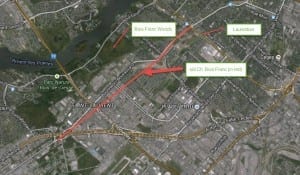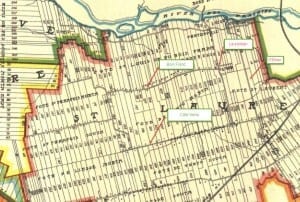We seek recollections about Petit Bois Franc in relation to an old farmers road. Also: How to Fly a Horse (2015)

Bois Franc today. We owe thanks to Tim Hewlings (MCHS 1963) for sending along this map. The source is Google Earth.

1907 map. The early map, Tim Hewlings notes, is from: A. R. Pinsoneault, Atlas of the Island and city of Montreal and Ile Bizard, s. l., The Atlas Publishing Co., vers 1907 found on the BANQ website.
A previous post concerns Petit Bois Franc in Montreal:
Graeme Decarie has a question about the old Bois Franc. Do you know the answer?
At the above-noted post, Alan McWaters has added a comment, which I am posting as a separate post in order to bring attention to it:
“I am writing memoirs about those times and recall a Petit Bois Franc which was connected to the old farmers road. Any recollections?
“P.S. My brother was bused to Malcom Cambell before Riverdale was built.”
If you can help Alan in his search for information, please contact me or post a message at the above-noted post.
Five-minute digital story based on MCHS 2015 Reunion
By way of an update on my own projects, I’m currently putting together a five-minute digital story based on the MCHS ’60s Reunion, which took place at Old Mill Toronto on Oct. 17, 2015. I’m taking a six-week course in Digital Storytelling at the Don Mills Library, taught by media artists Jennifer LaFontaine and Emmy Pantin. This is part of the Artists in the Library project at the Toronto Public Library.
I missed the first two or three classes but fortunately, there was an opening for the course when I turned up at the Don Mills Library one day. I had learned about the course when I was doing a search at the Toronto Public Library for books about Digital Storytelling.
Conflict and resolution
For the past couple of weeks, I have been preparing a 450-word voiceover text for my little video, which will be posted to Vimeo when it is done. I got some tremendous help from Jennifer LaFontaine in the development of the story, and Emmy Pantin helped me with the final touches on the script, and she worked with me on the recording go the voice track for the video.
A basic premise for such a script is that if a person were to say, by way of example, “”We had a reunion and it turned out great,” that would be remarkably boring. Film (or video: the words are interchangeable) makes particular demands on the structure of a story. You have to get across something that deals with conflict or change, as otherwise people tend to not pay attention.
At first I thought I would tell the story about how the MCHS 2015 organizing team was at one point in a real bind, facing a deficit of $2K, and how we came up with the perfect solution, which was to change the venue to a smaller room, a change that at once wiped out the potential $2K deficit.
However, Jennifer LaFontaine commented, when she saw my early draft, that dealing with the logistics of the organizing process was not exciting at all. But then, she thought that my concept of addressing the story an an instance when high school cliques were dissolved, for the occasion offered by the reunion, was definitely something that would appeal to many viewers. So we went with that.
I had written my original script as a typical blog post of a story, with a start, middle, and finish, and a somewhat formal, academic-type style that occurs to me as a matter of course. For the sake of the script, I would need to be a little less formal. I would need to write as if I was talking out loud. So I made some changes.
Another change had to do when I spoke about the fact that I served as the President of the Student Council during the 1962-63 school year at Malcolm Campbell High School. At Jennifer’s suggestion, I avoided saying at the start that I served as President. Instead, to make the story more interesting, I began by explaining, very briefly, that I ran for President, began my campaign speech with a strong statement about the kind of Student Council that I envisioned, and then, at the end of the brief overview, finally noted that I won the election by a landslide. I mean, why start of and say you were the President of the Student Council. Better to build up some tension, right?
I’ve been working with stories, in a focused way, for about a decade. Do I know everything there is to know about stories? I know nothing. Such a course, as the one I’m now taking, underlines that fact that a person can readily work with stories, and study stories night and day, for a decade and still not know much of anything about how to put them together.
Placement of story elements
As well, at the instructor’s suggestion, I took an item that was in the middle of the text and placed it right at the opening of the piece. Many parts, of my original text, were left out, so that we could end up at 450 words. Actually it came to 452 words as I recall, but that is close enough.
Zoom H5 audio recorder
We did our recording, paragraph by paragraph, in a small booth at the Don Mills Library. We used my Zoom H5 recorder, equipped with a windscreen, which I like to use for such recordings. The room has some interesting acoustical properties. Your voice bounces right off the ceiling; the booth is a tightly enclosed, tiny space.
Here are some resources that I’ve found handy, as I think about the acoustic properties of recording studios, and about the creative process in general:
Handbook of sound studio construction: rooms for recording and listening (2012)
How to build a small budget recording studio from scratch (2012)
The art of mingling: fun and proven techniques for mastering any room (2015)
The business of event planning: behind-the-scenes secrets of successful special events (2002)
How to Fly a Horse (2015)
I learned about the above-noted excellent resource when I heard interviews with the author on CBC The Current and CBC Spark.
March 13, 2015 interview at CBC The Current: Kevin Ashton dismantles creative genius in ‘How to Fly a Horse’
March 22, 2015 interview at CBC Spark: Creativity isn’t magic.
How to fly a horse : the secret history of creation, invention, and discovery (2015)
A blurb for the latter study notes:
Inspiring and empowering, this journey behind the scenes of humanity’s greatest creations reveals the surprising way we make something new. What do Thomas Jefferson’s ice cream recipe, Coca Cola, and Chanel No. 5 have in common? They all depended on a nineteenth-century African boy who, with a single pinch, solved one of nature’s great riddles and gave birth to the multimillion-dollar vanilla industry. Kevin Ashton opens his book with the fascinating story of the young slave who launched a flavor revolution to show that invention and creation come in unexpected shapes and sizes. From the crystallographer’s laboratory where the secrets of DNA were first revealed by a long-forgotten woman, to the electromagnetic chamber where the stealth bomber was born on a 25-cent bet, Ashton weaves tales of humanity’s greatest creations to unpack the surprising true process of discovery. Drawing on the Amish and the iPhone, Kandinsky and cans of Coke, Lockheed, South Park, and the Wright brothers–who set out to “fly a horse”–he showcases the seemingly unremarkable individuals, gradual steps, multiple failures, and countless ordinary–and usually uncredited–acts that led to our most astounding breakthroughs. Creators, he shows, apply everyday, ordinary thinking that we are all capable of in particular ways, taking thousands of small steps, working in an endless loop of problem and solution. He explores why innovators meet resistance and how they overcome it, why most organizations stifle creative people, and how the most creative organizations work. In a passionate and profound narrative that amazes and inspires, Ashton’s book sheds new light on how “new” comes to be.
[End of text]
Notes:
I’ve chosen not to break the above long paragraph into shorter ones. It’s worth a read but it will take you a few moments to read it. I’ve saved a few moments by not breaking it into shorter paragraphs. As well, I’ve gone with the lower-case approach to titles that the Toronto Public Library uses. It makes for easier reading, at times. For the heading for this post, I’ve gone with the standard title approach to titles, using capitalizations.

Janet Barnes has commented on Facebook: Bois Franc was from Pitfield to after Laurentien but it went straight into the Canadair airfield to a dead end that I lived on….but at the French farmers property (Brussel sprouts & chickens) after the fruit stands ….where I could buy 2 paper bags full for $3.00, there was a left turn…. which went north instead of continuing east…..and then turned right or east to go around the cadets airfield towards Laurentien . My home was 150 yrs old. In 1966.
It’s really interesting to read your description, Janet. I think there is such tremendous value in retaining details related to local history, wherever in the world we may be living. The internet occasionally gives us opportunities to retain such details, that help bring the past to life, in our imaginations.
I remember getting on my bicycle and going to a sea food store on Bois Franc road. I think I may have been 12 or 13 so that would make the year 1964 or 1965. One week it was haddock and the following week it was halibut. Talk about a small world. A few years ago I discovered how Janet Barnes and I are related. Her great grandfather was my grandfather’s older brother. Hi Janet!